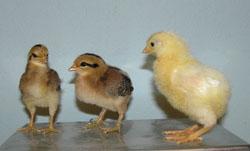Developmental differences in behaviour and morphology between two captive populations of red jungle fowl (Gallus gallus) and one population of White Leghorn (Gallus gallus domesticus)
- implications for conservation
More and more species are threatened by extinction. In order to prevent that from
happening, several actions can be taken, such as in situ and ex situ conservation. In in situ ,
one protects a habitat and all the species in it. In ex situ , one take animals into captivity and
breed them with the intention of releasing them back into the wild when their natural habitats
are safe for them again.
When animals are taken from the wild, their environment will change dramatically. They face
different challenges such as a different group composition and less space, but on the other
hand they are sheltered from predators and harsh weather and are provided with food and
water. These circumstances together with the restrictions in mate choice, may lead to
unintentional changes in the animals. After some generations, these changes may affect the
animals’ ability to survive when being released back into the wild. The changes may also
resemble changes connected to domestication and thus they are not wanted. To prevent such
changes, one needs to know what is causing them and how they affect survival.

Aim of the study
The aim of this study was to investigate the development of social behaviour, morphology and captive induced neoteny between two populations of Red jungle fowl (RJF) and one population of White Leghorn layers (WL).
Responsible for this page:
Director of undergraduate studies Biology
Last updated:
06/07/06
